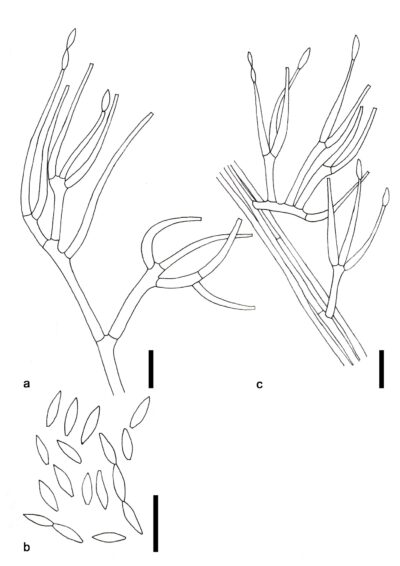Fungalpedia – Note 297, Chlorocillium
Chlorocillium Zare & W. Gams
Citation when using this entry: Perera et al. 2024 (in prep) – Fungalpedia, genera described in 2016.
Index Fungorum, Facesoffungi, MycoBank, GenBank, Fig. 1
Classification: Incertae sedis, Incertae sedis, Incertae sedis, Sordariomycetes, Pezizomycotina, Ascomycota, Fungi
Zare & Gams (2016) introduced Chlorocillium to accommodate Chlorocillium griseum based on LSU, SSU and ITS sequence data. Chlorocillium species are entomogenous (Zare & Gams 2016; Tan & Shivas 2023, 2024). Chlorocillium is characterized by dry, slow-growing, greenish-ochraceous colonies producing hyphomycetous asexual morphs. Short conidiophores bear meagre whorls of phialides. The conidia are fusiform and occur in dry chains. The genus currently accommodates three species (Zare & Gams 2016; Tan & Shivas 2023, 2024). However, the sexual morph retains undetermined. Tan & Shivas (2023) accepted Chlorocillium in Sordariomycetes, incertae sedis.
Type species: Chlorocillium griseum (Petch) Zare & W. Gams
Figure 1 – Chlorocillium griseum (a, b: CBS 387.73, epitype; c: CBS 101243). a–c Conidiophores and conidia. c–g Conidia. Scale bars: a–c = 10 μm. Redrawn from Zare & Gams (2016).
References
Tan YP, Shivas RG. 2023 – Nomenclatural novelties. Index of Australian Fungi 22, 1–14.
Tan YP, Shivas RG. 2024 – Nomenclatural novelties. Index of Australian Fungi 31:1–12.
Entry by
Rekhani Hansika Perera, Center of Excellence in Fungal Research, Mae Fah Luang University, Chiang Rai, 57100, Thailand.
(Edited by Kevin D. Hyde, Samaneh Chaharmiri-Dokhaharani, & Achala R. Rathnayaka)
Published online 8 July 2024
